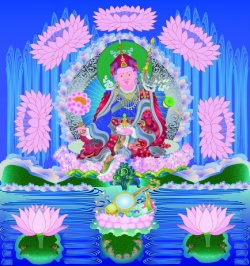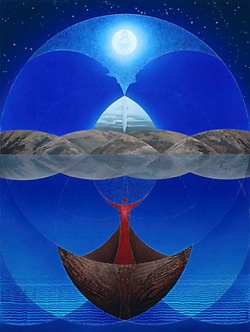Women in Buddhism
By Rev. Patti Nakai
Shinran and the 35th Vow
Revised September, 2002
So profound is Amida’s great compassion
That, manifesting inconceivable Buddha-wisdom,
The Buddha established the Vow of transformation into men,
Thereby vowing to enable women to attain Buddhahood
-From Jodo Wasan (p. 341, The Collected Works of Shinran, Vol. 1,
Dennis Hirota et. al., trans., Kyoto: Jodo Shinshu Hongwanji-ha, 1997)
According to the ceremonial rulebooks for priests, the above wasan (type of Japanese verse) is supposed to be chanted at the funerals for women, but there was considerable objection to the practice in Japan and most temples in America tend to chant a more standard wasan at funerals regardless of the deceased’s gender. But the above wasan is important in revealing how Shinran felt about women who were very much alive.
In the Chinese version of the Immeasurable Life Sutra (also known as the Larger Sukhavativyuha Sutra), there are 48 vows made by the seeker Dharmakara to his teacher Lokesvararaja. The most essential of these is the 18th vow, known as Hongan (main-vow), where Dharmakara proclaims that his enlightenment cannot be complete unless he can be called by the Name "Namu Amida Butsu" (meaning, the one who bows down, namu, to all beings, Amida, as enlightened, Butsu).
In the same spirit of Hongan's reverent view of all beings as existing in the state of enlightenment (Pure Land), the other vows deal with overcoming specific forms of discrimination which prevent us from seeing certain people as Pure Land residents. For example, vow #3 deals with racism ("all skin colors will be seen as glowing like precious gold") and vow #38 deals with dress codes ("all garments will be considered acceptable for Buddhas to wear no matter how torn, discolored or dirty").
Although the 35th vow represents Dharmakara’s overcoming of his sexist view, in Japanese Buddhist history, the text of the vow has been interpreted as a rationale for discrimination against women. One widely accepted translation reads:
"If...women of the [Buddha-worlds] who, having heard my Name, rejoice in faith, awaken aspiration for Enlightenment, and wish to renounce womanhood* should be reborn again as women**, may I not attain perfect Enlightenment."
(p. 37, The Three Pure Land Sutras, Hisao Inagaki, trans., Berkeley: Numata Center, 1995)
In the above interpretation, life as a woman is a terrible state of existence that must be renounced and avoided in future rebirths in order to attain enlightenment. You can see how this became a justification for Buddhist sects to limit the role of women in the temples. Yet at the same time, the men in control assured women that their contributions of money and labor to the temples were not in vain since they still had a future chance of salvation. With this attitude directed at them, women felt unworthy of enlightenment because of their female bodies. It was sad to read in one book about Japanese Buddhism that the writer overheard one female temple member say to another while hard at work at a benefit function, "I really hate being a woman, don't you?"
During my studies in Japan, I found there is a different way of interpreting the 35th vow. One of my professors at Otani University, Akira Hataya, said the use of the word nyonin in Chinese translations of Buddhist texts, though normally read as a compound noun "female-person" (i.e., woman), could also be read as an adjective and noun memeshii hito, "effeminate (weak, wimpy) person," referring to either a man or a woman. From this, I came to feel that Buddhist texts are not trying to exclude women from the path to enlightenment, but rather the Teachings admonish both sexes not to fall into the negative traits stereotyped as "feminine" - that is, being cowardly, manipulative, or parasitic on others. There are plenty of passages in the sutras which encourage both sexes to emulate the positive aspects of femininity - to be nurturing, compassionate and sensitive towards others.
From ancient times to the present, women much more than men have been relegated to the role of "sex object," existing only to be pleasing to men's sight and other senses. The woman who seeks enlightenment, however, must break free of the mad pursuit to live up to that stereotype, and see that she is not just an object for others' pleasure. In other words, in the enlightened world, the Pure Land, women will be seen and see themselves as human beings equal to men, not as inferior objects. See how different the 35th vow sounds when we put in an objectifying term such as "bimbo."
"May I attain the highest enlightenment only when women who hear my Name realize how demeaning it is to be seen as a bimbo and in their new life of seeking the Dharma, their joy and faith will keep them from ever wanting to be seen as a bimbo again."
Shinran in his day did not have the benefit of such a progressive interpretation, but he came to a similar conclusion through his own experience of the Nembutsu. Shinran did not question the prevailing belief that women were too defiled to be enlightened. However, to think that a woman's body would be more corrupt than a man's did not matter much when Shinran already felt that the human body itself was irredeemably corrupt - full of desires and angers which cannot be quieted for more than a few moments at a time. He questioned the claims that there were actual people who totally conquered their bodily functions and manifested the so-called "marks of the Buddha" (such as special swirls on the feet and the retraction of private parts).
According to Shinran, complete enlightenment cannot be attained as long as we exist as biological creatures, yet once we awaken to the truth that our individual lives are embraced by Infinite Life (Amida), it means complete enlightenment will definitely occur. Shinran often uses the phrase, "equal to Maitreya," meaning that despite our defiled bodies, we are on the brink of enlightenment like the prototype Maitreya, the "Buddha-to-be." To Shinran, since each "Buddha-to-be" will inevitably arrive at the Pure Land like Maitreya, they can start enjoying the benefits of enlightenment here and now, rather than waiting for the distant future.
This absorption of a future inevitability into the present moment also characterizes Shinran's attitude towards women. In the above wasan, Shinran praises Amida's power to change a being in a separate category labeled "women" to a someone in the same "Buddha-to-be" category of all men. Since Shinran believes this will definitely occur, he can consider all women as "Buddhas-to-be" equal to any man. The power of the all-encompassing Infinite Life breaks down what the people of Shinran's time saw as women's biological obstacle on the spiritual path.
I believe that due to cultural conditioning, some women may require different approaches to religion than most men, just like some Americans need to approach Buddhism differently than most Japanese. But whatever your gender, race, economic status, etc., the 48 vows in the Immeasurable Life Sutra point out that there is no discrimination against anyone on the path to spiritual truth. If anyone tries to tell you otherwise, be assured that the Buddha's words won't support them.
Notes:




